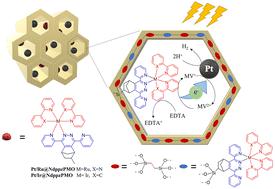当前位置:
X-MOL 学术
›
Dalton Trans.
›
论文详情
Our official English website, www.x-mol.net, welcomes your feedback! (Note: you will need to create a separate account there.)
Ru- and Ir-complex decorated periodic mesoporous organosilicas as sensitizers for artificial photosynthesis
Dalton Transactions ( IF 4 ) Pub Date : 2022-11-22 , DOI: 10.1039/d2dt03147g Raúl Rojas-Luna 1 , Miguel Castillo-Rodríguez 2 , José R Ruiz 1 , César Jiménez-Sanchidrián 1 , Dolores Esquivel 1 , Francisco J Romero-Salguero 1
Dalton Transactions ( IF 4 ) Pub Date : 2022-11-22 , DOI: 10.1039/d2dt03147g Raúl Rojas-Luna 1 , Miguel Castillo-Rodríguez 2 , José R Ruiz 1 , César Jiménez-Sanchidrián 1 , Dolores Esquivel 1 , Francisco J Romero-Salguero 1
Affiliation

|
A versatile and facile strategy based on an inverse electron demand Diels–Alder reaction between 5-norbornen-2-yltriethoxysilane and a tetrazine derivative has been established for the synthesis of a new triethoxysilane precursor containing dipyridylpyridazine units. Such a precursor has been incorporated into the mesostructure of an ethylene-bridged periodic mesoporous organosilica (PMO) material through a one-pot synthesis via a co-condensation method. Upon attachment of Ru- and Ir-complexes to the pendant N-chelating heterocyclic ligands, the resulting decorated PMOs have acted as photosensitizers in artificial photosynthetic systems. The deposition of Pt on these PMOs has allowed us to obtain efficient photocatalytic materials for the hydrogen evolution reaction as a result of electron transfer from the light harvesting Ru- and Ir-complexes to the supported Pt nanoparticles through methyl viologen as an electron relay. They have exhibited total turnover number values of 573 and 846, respectively, under visible light irradiation. The role played by each component and the stability of the photocatalytic systems have been discussed. The present approach paves the way to the synthesis of different materials with coordination sites capable of forming surface complexes to be applied as sensitizers and catalysts.
更新日期:2022-11-22



























 京公网安备 11010802027423号
京公网安备 11010802027423号